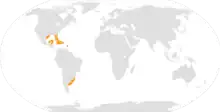| Lesser devil ray | |
|---|---|
_(6001273001).jpg.webp) | |
| Scientific classification | |
| Domain: | Eukaryota |
| Kingdom: | Animalia |
| Phylum: | Chordata |
| Class: | Chondrichthyes |
| Subclass: | Elasmobranchii |
| Superorder: | Batoidea |
| Order: | Myliobatiformes |
| Family: | Mobulidae |
| Genus: | Mobula |
| Species: | M. hypostoma |
| Binomial name | |
| Mobula hypostoma (Bancroft, 1831) | |
 | |
| Range of Mobula hypostoma, not including M. rochebrunei | |
| Synonyms | |
| |
The lesser devil ray (Mobula hypostoma) is a species of devil ray in the family Mobulidae.
Habitat
These rays live in shallow, warm waters and can be found in shoals of up to 40 individuals, although more often ranging between 2 and 10.[4]
They occur along the coasts of the western Atlantic, from North Carolina to northern Argentina.[5] The related Mobula rochebrunei has occasionally been recovered as a junior synonym of M. hypostoma, extending the species' range to the eastern Atlantic.[6]
Diet
They mostly feed on zooplankton such as small crustaceans, although they can occasionally eat schooling fish, using their cephalic horns to funnel prey into their mouth.[5]
Description
Lesser devil rays are relatively small, with a maximum width of about 125 cm (49 in). They have forward-facing cephalic horns, while their long spineless tails distinguish them from their relatives M. mobular.[4][5]
Dorsal coloration varies from light brown to black, although some specimens have been reported as blue.[5] Individuals sometimes possess a dark grey collar between their spiracles.[4]
References
- 1 2 Marshall, A.; Barreto, R.; Carlson, J.; Fernando, D.; Fordham, S.; Francis, M.P.; Herman, K.; Jabado, R.W.; Liu, K.M.; Rigby, C.L.; Romanov, E. (2019). "Mobula hypostoma". IUCN Red List of Threatened Species. 2019: e.T126710128A896599. doi:10.2305/IUCN.UK.2019-3.RLTS.T126710128A896599.en. Retrieved 20 November 2021.
- ↑ "Appendices | CITES". cites.org. Retrieved 2022-01-14.
- ↑ Boonstra, Roxane. "Atlantic devil ray". Florida Museum of Natural History. Retrieved 8 December 2011.
- 1 2 3 "West Atlantic Pygmy Devil Ray (Mobula hypostoma)". Manta Trust.
- 1 2 3 4 "Mobula hypostoma". Florida Museum.
- ↑ White, W.T., Corrigan, S., Yang, S., Henderson, A.C., Bazinet, A.L., Swofford, D.L. and Naylor, G.J.P. 2017. Phylogeny of the manta and devilrays (Chondrichthyes, mobulidae) with an updated taxonomic arrangement for the family. Zoological Journal of the Linnean Society 182(1): 50-75. https://doi.org/10.1093/zoolinnean/zlx018.
- "Mobula hypostoma". Integrated Taxonomic Information System. Retrieved 18 April 2006.
- Froese, Rainer; Pauly, Daniel (eds.) (2006). "Mobula hypostoma" in FishBase. February 2006 version.
- C. R. Robins & G. C. Ray (1986). A field guide to Atlantic coast fishes of North America. Boston: Houghton Mifflin Company.
External links
- Photos of Lesser devil ray on Sealife Collection
